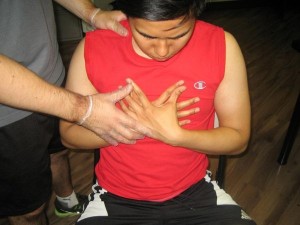Flail chest occurs when a portion of the rib cage is separated from the rest of the chest wall. Specifically, it is when at least two fractures per rib are separated from the chest wall. This is frequently due to severe blunt trauma to the chest. In a situation where an individual has a flail chest, the portion affected by the flail chest will be unable to contribute to the expansion of the lungs, thus interfering with normal chest movements. In turn, the chest cannot expand normally and will fail to draw air into the lungs. Consequently, there is difficulty breathing. The main significance of a flail chest is that it is indicative of an underlying pulmonary contusion, a bruise of the lung. Flail chest is a serious condition that if left untreated can lead to complications such as long-term disability and even death.
Causes of Flail Chest

A flail chest is commonly caused by severe blunt trauma to the chest. Some of the most common causes include:
- Motor vehicular accident
- Serious falls or falls from great heights
- Physical assaults
- In older patients, may be caused by bone disease or deterioration (very rare)
Signs and Symptoms of Flail Chest
A flail chest can be diagnosed by taking an x-ray, but the following are the common telltale signs and symptoms:
- Paradoxical movement of a portion of the chest wall (affected area draws in when the patient inhales and the rest of the chest expands, and the affected area moves out as the patient breathes out and the remainder of the chest contracts)
- Bruising, grazing and/ or chest discoloration
- Chest pain
- Difficulty breathing
- In case of car accidents, indicative markings from a seat belt
First Aid Management for Flail Chest
If anyone is suspected of flail chest or any kind of chest trauma or injury, one must seek medical help immediately to prevent any of the complications mentioned above. To ensure that proper care is given, follow the instructions as follows:
- Call for emergency medical assistance and give all necessary information. If the operator gives instructions, follow the instructions given.
- Assist the victim into finding the most comfortable resting position to make breathing as comfortable as possible.
- Instruct the victim to stay as motionless as possible to avoid any unnecessary injuries.
- Splint the chest with a soft object against the injured area or use bandages to hold the pillow or any soft material in place.
A flail chest occurs when at least two ribs are separated from the rest of the chest wall, “floating” in place. It commonly occurs due to severe blunt trauma. The most obvious sign is paradoxical breathing. It is considered a medical emergency that needs immediate treatment. To learn more about how to manage a flail chest, enroll in First Aid and CPR Courses with St Mark James Training.
Online Sources:
http://firstaid.about.com/od/shortnessofbreat1/ht/09_Treat_Flail_Chest.htm
http://www.trauma.org/archive/thoracic/CHESTflail.html
http://www.urmc.rochester.edu/encyclopedia/content.aspx?contenttypeid=22&contentid=flailchest
